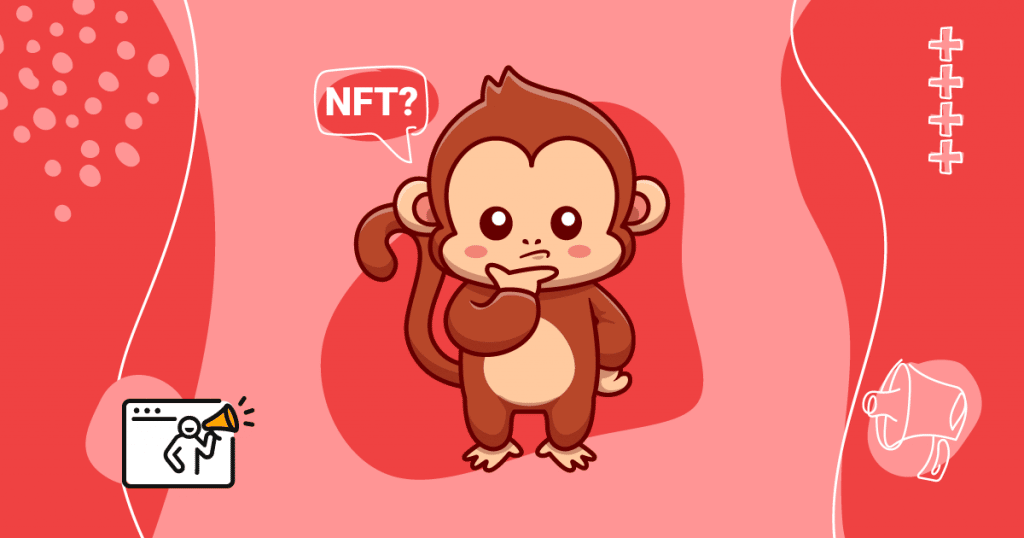As any long-time digital marketer can tell you, a successful digital content marketing plan is all about meeting people where they live, the better to connect to them and get your message across.
A considerable part of that equation involves staying on top of the latest digital trends. When you know what’s hot, you can effectively put your own spin on it and leverage it to get ahead.
NFTs are one of the hottest trends to come along in a while, and they’re taking the digital marketing world by storm in a big way.
But not every marketer has a solid digital understanding of what they are, how they work, and how they can be integrated into a brand-specific digital marketing campaign.
That’s exactly why we’ve put together our very own NFT for dummies guide to bring you up to speed fast so you can start putting NFTs to work for you.
Let’s dive into what you need to know to get started!
What Exactly are NFTs?
The acronym NFT stands for “non-fungible token.”
Similar to cryptocurrencies like Bitcoin, NFTs are digital assets that can be purchased, sold, and traded at will, just as you could anything else you owned.
As you might surmise from the word “token,” NFTs are indeed tokenized. This means that each one is unique and unlike any other, including other versions of the asset the NFT is based on.
When something is tokenized, it’s attached to a digital certificate of ownership that proves as much.
However, to truly grasp NFT for dummies, you also need to understand what the term “fungible” means.
If something is fungible, it can easily be exchanged for something similar or equal to it in value. (Bitcoin is an excellent example of a fungible digital asset, as each Bitcoin is equal in value to every other.)
A non-fungible asset, on the other hand, is one of a kind and has no equivalent.
Many of the world’s most valuable assets, like rare diamonds and original masterpieces like the Mona Lisa, are as valuable as they are because they’re non-fungible — irreplaceable with no true equivalent.
NFT for Dummies: Non-Fungible Tokens and Blockchain
If you’re at all in the know about Bitcoin, Ethereum, and other cryptocurrencies, then you’re already somewhat familiar with blockchain technology.
A blockchain is a database used to store various pieces of digital information in chronological order. These pieces are called blocks.
Blockchains are also decentralized, meaning their control is spread across several different authorities, offices, or entities instead of just one.
The decentralized nature of blockchains allows buyers and sellers to deal directly with one another instead of working through a middle man or other authority.
When someone decides to purchase an NFT, they naturally won’t be getting a physical asset to hold as they would if they bought an original painting by Van Gogh.
Instead, their purchase of the original digital asset is recorded in a public blockchain ledger accessible by millions of computers worldwide.
That record serves as proof of ownership and value for the associated NFT.
Why are NFTs Being Sold for Millions of Dollars?
That’s one NFT for dummies question nearly everyone has these days — why are some NFTs selling for thousands, if not millions, of dollars?
In fact, it’s those multi-million-dollar sales that are fueling the current NFT craze.
For example, the original Nyan Cat GIF sold recently for over half a million dollars. Many digital artists have sold original artwork as NFTs for multiple millions of dollars, including singer-songwriter Grimes.
There’s even an NFT out there representing the very first Twitter tweet, an asset worth a good 2.5 million dollars.
Just as cryptocurrency is considered by many to be the digital world’s answer to traditional money, there are those out there who see NFTs as the digital answer to valuable collectibles like art, original music, and so much more.
And if non-digital assets can sell for millions of dollars, it should also make sense that digital ones can, as well.
How Brands are Using NFTs for Better Results
Modern artists, musicians, and internet legends aren’t the only people capable of leveraging the exclusivity factor attached to NFTs to build an audience and turn a profit.
Brands are also using them to lend additional value to original digital brand assets like video, audio, original artwork, and more.
The way NFTs are growing in popularity right now has allowed innovative, forward-thinking brands to connect with consumers in exciting new ways.
They’re also using NFTs to boost their brand storytelling strategies in ways that generate buzz and turn heads.
And you don’t have to be a huge global brand to put NFTs to work for you, either. With a bit of know-how and creativity, any brand can use them to stand out and connect with audiences in incredible new ways.
What are the Biggest Benefits of Using NFTs as a Brand Marketer?
Remember, the key to a genuinely snappy digital marketing campaign that really turns heads is the ability to connect it to red hot digital trends people are interested in.
So it goes without saying that mastering NFT for dummies and finding unique ways to work NFTs into your marketing strategy comes with some serious benefits.
Limitless Versatility
One of the most significant advantages NFTs bring to the table for digital marketers is their sheer versatility.
An NFT can be used to represent absolutely anything you can think of, and big brands are using that to their advantage.
NFTs are a way of selling value, as opposed to simply selling products, so the possibilities are endless. Think virtual real estate, exclusive fashion, original art, and just about anything else you can imagine.
Direct Connection
The NFT market makes it possible for creators and brands to eliminate many of the costs associated with manufacturing, storing, and shipping physical goods.
Instead of worrying about all these middlemen, there’s a direct connection between the brand and the consumer on the other end of the transaction.
And for some brands, especially those in the business of selling a lifestyle, the value lies in the brand itself, as opposed to any of the actual goods. This makes the selling of exclusive assets a pretty good bet.
Superior Branding
Perhaps the biggest benefit of NFTs for today’s brands is the potential for truly next-level brand-building.
Unique assets like NFTs give digital-age companies a unique opportunity to forge valuable connections with customers by bringing them in on something exclusive.
Plus, it pays to be an early adopter when it comes to huge digital trends. The first brands to move on something new often generate the most buzz and get the most attention, especially if they’re coming up with genuinely one-of-a-kind ideas.
The Best NFT Examples This Year
Now you know the basics about NFT for dummies. You also know a bit about why your brand might want to consider integrating them into your current digital marketing strategy.
Now it’s time to take a closer look at some of the coolest, most iconic NFTs to know this year. Take note and get inspired!
Bored Ape Yacht Club
Also known as BAYC, the Bored Ape Yacht Club launched in April of 2021. It’s an exclusive collection of digital apes, each with its own unique look and traits.
Naturally, some of these traits are much rarer than others, so an ape with several extremely rare features could potentially sell for a lot of money. (There are currently a few with multi-million-dollar values attached to them.)
Each exclusive ape also serves as a membership card to the Yacht Club virtual space, complete with access to multiple members-only features.
SandBox
Just like NFTs, virtual metaverses are all the rage these days, and SandBox is currently one of the most popular.
SandBox users can buy, sell, and collect a wide variety of different digital goods, including but not limited to virtual land, unique clothing items, and a variety of other collectibles.
Like the Bored Ape Yacht Club, SandBox has made its share of headlines lately, thanks to several rather large NFT sales. One of the most noteworthy was the sale of the Metaflower Super Mega Yacht NFT for approximately $650,000.
It’s also worth noting that several major brands are already very much on board with SandBox and have purchased valuable digital land there. Examples include Adidas, Atari, and Etoro.
Taco Bell
Taco Bell is a great example of an iconic modern brand that recently leveraged NFTs in its marketing strategy to the tune of great results.
The popular fast-food chain released 25 unique GIFs. Each GIF cost approximately $1, just like an original Taco Bell taco.
It only took around 30 minutes for all of the Taco Bell GIFs to sell out. Today, each GIF continues to resell, generating royalties in the process.
Taco Bell donates all royalties to the Taco Bell Foundation, which awards millions of dollars in grants and scholarships to deserving recipients.
Wrap Up: Keep Up with Digital Trends and Stay Ahead of the Competition
Learning the ropes in regards to NFT for dummies is one great way to stay ahead of the curve and keep your brand on trend this year, but you don’t want to stop there.
The earlier a marketer can prepare for the next big thing, the better their chances of staying ahead of their competition and making all the right waves.
Stay in the know when it comes to all of today’s hottest, newest digital marketing trends when you subscribe to The Beat, Rock Content’s official newsletter.
Every single Friday, we’ll deliver the hottest, freshest need-to-know info directly to your inbox. Get on board today!







